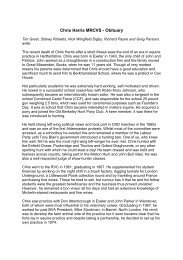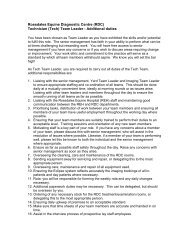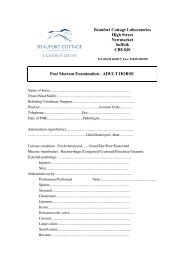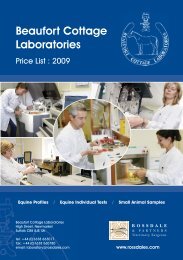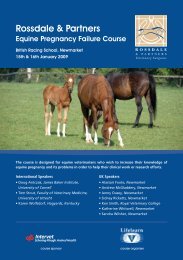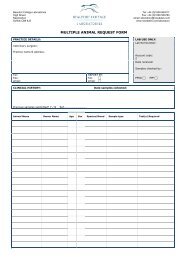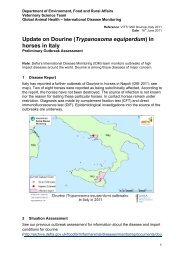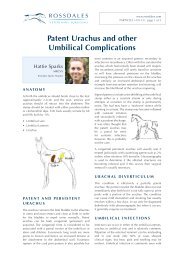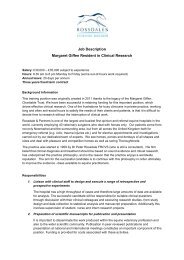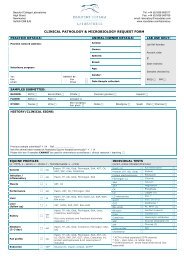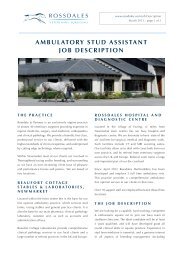EQUINE CLINICAL PATHOLOGY - Rossdale & Partners
EQUINE CLINICAL PATHOLOGY - Rossdale & Partners
EQUINE CLINICAL PATHOLOGY - Rossdale & Partners
Create successful ePaper yourself
Turn your PDF publications into a flip-book with our unique Google optimized e-Paper software.
G u i d e t o e q u i n e c l i n i c a l p a t h o l o g y<br />
about liver function. The liver has a large<br />
functional reserve and compensatory<br />
capacity. Liver enzyme rises suggest<br />
hepatopathy which can be differentiated<br />
to a degree into acute, chronic, biliary<br />
obstructive or mixed pathology, but bile<br />
acid assays and bromsulphalein clearance<br />
test results reveal either adequate (normal<br />
levels) or impaired (high levels) functional<br />
compensation. Impaired hepatic function<br />
suggests a guarded prognosis. Liver biopsy<br />
and ultrasound examinations are required<br />
to confirm an etiologic diagnosis and to<br />
refine prognosis.<br />
Amylase<br />
Elevations occur in the presence of<br />
pancreatitis, but this condition is rarely<br />
diagnosed in the horse.<br />
Glucose<br />
Other than for oral glucose and xylose<br />
absorption tests, useful for the diagnosis<br />
and evaluation of intestinal malabsorption<br />
cases, the value of this assay in adult<br />
horses is limited to cases of pituitary<br />
pars intermedia dysfunction (equine<br />
Cushing’s syndrome) which are frequently<br />
hyperglycaemic. Measurement of blood<br />
glucose is invaluable in the management of<br />
critically ill foals as profound hypoglycaemia<br />
is often seen in neonatal septicaemia.<br />
Samples for glucose assay must be taken<br />
into fluoride anticoagulant or must reach<br />
the laboratory within hours of collection.<br />
Oral Glucose Absorption Test<br />
The horse to be tested should be fasted<br />
for 18-24 hours. 1 g glucose per kg body<br />
weight is administered by stomach tube.<br />
Blood samples are collected into fluoride<br />
anticoagulant at times 0, 30, 60, 90, 120,<br />
150, 180, 210 and 240 mins. Glucose<br />
levels should peak at double resting (0<br />
mins) levels at 60-120 mins and return to<br />
resting levels by 240 mins.<br />
Cholesterol and Triglycerides<br />
Elevations are seen in the presence<br />
of abnormal lipid metabolism and<br />
hyperlipidaemia. These conditions are<br />
typically seen in the Shetland and other<br />
small ponies, donkeys and occasionally as<br />
a secondary complication in horses that<br />
are anorexic or unable to eat. Pregnant<br />
Shetland pony mares appear particularly<br />
susceptible following a managemental and<br />
nutritional change/challenge.<br />
Urea<br />
Urea is produced in the liver from the<br />
metabolism of ammonia. Elevations are<br />
seen in the presence of abnormal renal<br />
function. Urea levels may also rise in<br />
the haemoconcentrated and ‘over-trained’<br />
horse, associated with fluid balance shifts<br />
rather than renal disease. Many cases<br />
of equine dysautonomia (‘grass sickness’)<br />
have a degree of uraemia but this is<br />
usually caused by catabolism. A period<br />
of anorexia can have a similar result.<br />
29



